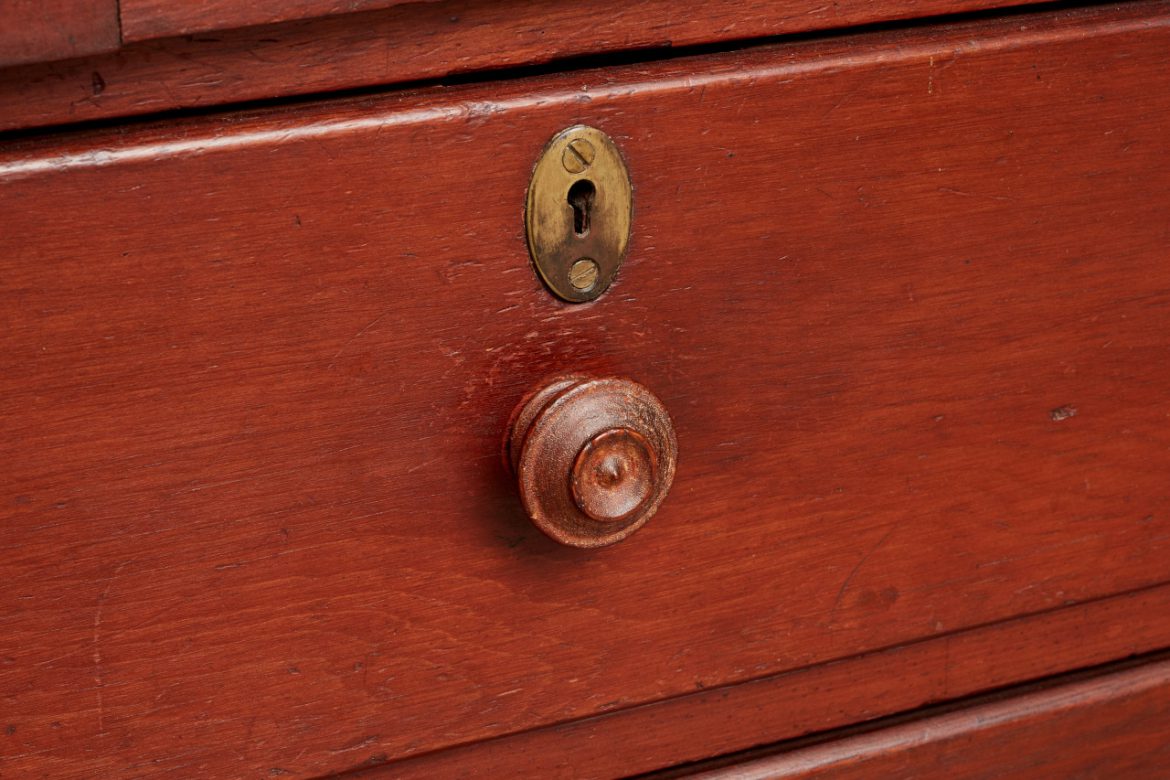
Pieces of furniture made by the Shakers do not necessarily remain in the form in which they were made. Some merely show wear and tear, some have been refinished, and some have had decorative and structural changes made to them. These changes may have been done by the Shakers themselves or may have been done after the piece left […]
Pieces of furniture made by the Shakers do not necessarily remain in the form in which they were made. Some merely show wear and tear, some have been refinished, and some have had decorative and structural changes made to them. These changes may have been done by the Shakers themselves or may have been done after the piece left its Shaker home. For example, on pieces made during the second half of the nineteenth century the Shakers occasionally used white porcelain or brown stoneware drawer pulls instead of the more traditional wooden or brass ones.

Photograph, “Eldress Room,” South Family Dwelling, Mount Lebanon, NY, 1930, Historic American Buildings Survey, http://hdl.loc.gov/loc.pnp/hhh.ny0118/photos.115359p, William F. Winter, Jr., photographer.

Eldress’s Desk, (Lot 223) Shaker Auction: Willis Henry Auctions, Inc., August 3, 1986, 1986, Willis Henry Auctions, Inc.
A desk made by Elder Amos Stewart in 1873 appears in a photograph made by William F. Winter, Jr., in 1930 with white porcelain drawer pulls. By 1986, when the desk was offered for sale at auction, the pulls on the lower drawers had been replaced with wooden pulls.

Case of Drawers, Church Family, Mount Lebanon, NY, Ca. 1820, Shaker Museum | Mount Lebanon: 1950.596.1. John Mulligan, photographer.
The piece being considered in this blog post, a case of drawers with cupboards above the drawers, was similarly modified. In this instance, most likely common wooden drawer pulls were replaced by commercially-made decorative wooden drawer pulls. This work was undoubtedly done by or for Shakers. The reason for this modification is part of a significant event in the history of the Mount Lebanon Shakers. On February 6, 1875, the Church Family at Mount Lebanon experienced a devastating fire. It started in the family’s Wood House / Sisters’ Workshop due to the careless disposal of hot ashes and soon spread to the Dwelling, the Ministry’s Workshop, the Ice House, a Barn, the Gas House, and a Storehouse. All of these were total losses but the greatest loss was the Dwelling House with its furniture and personal possessions. Nearly 100 Shakers were displaced and the Shakers rebuilt as quickly as possible. The resulting building, completed in 1877, was built of brick with a slate roof to make it as impervious to fire as possible.
At this period in Shaker history it would have been difficult for the Shakers to replace with their own labor the quantity of furniture that had been lost. As a consequence, beds, tables, and cases of drawers were commissioned from outside cabinetmakers. These essential pieces of furniture were supplemented with older Shaker pieces no longer needed in other places. The case of drawers discussed here may have seen in service in a building not damaged by fire or possibly it was donated to the Church Family by one of the other families at Mount Lebanon. By this date, several of the families had lost significant numbers of members and it is certain that there was surplus furniture.

Pedestal Table, Church Family, Mount Lebanon, NY, 1877, Published in Shaker: The Art of Craftsmanship, The Mount Lebanon Collection, (Alexandria VA: Art Services International, 1995), p. 95, Mark Daniels, photographer.
The new dwelling house, while not built in the most elaborate style of the period, was certainly a more modern structure than the one it replaced. In keeping with the style of the building some of the older furniture was “upgraded” to better fit with the new furniture that was used. Carpenters were hired to build a number of round and oval pedestal tables for the Brethren’s rooms. Some of these tables had drawers and the pulls that were used on these drawers were more decorative than was typical of Shaker pieces. Apparently, in an effort to help the older case of drawers fit with the new furnishings, the same decorative pulls were installed on the cupboard doors and drawers of the 1820s piece.
A present day consequence of this decision by the Shakers is that this particular piece has not often been selected by curators seeking classic pieces of Shaker furniture for exhibitions. Betrayed only by its pulls, every other element in the design and construction of this piece speaks clearly to the most classic period of Shaker furniture-making. The case of drawers was acquired prior to 1947 by the Museum’s founder John S. Williams, Sr. This piece had last been used by Sister Emma J. Neale at Mount Lebanon.